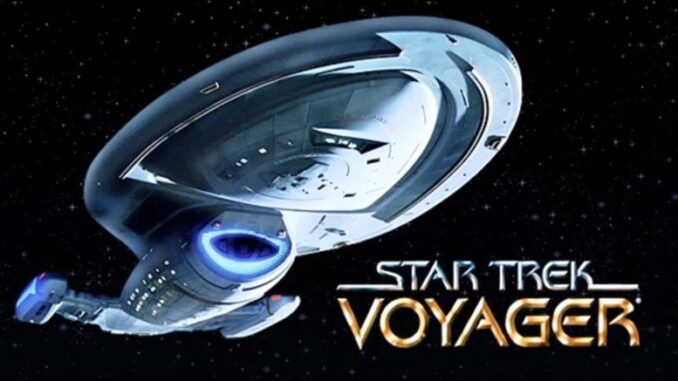
From a writer’s standpoint, one of the most interesting aspects of the mid-90s Star Trek shows (Star Trek: Voyager, Star Trek: Deep Space Nine) was that their writers/producers would listen to story idea pitches from unagented writers1. This was extremely unusual; for every other TV show I’ve heard of, you can’t even get your foot in the door unless you’ve got a Hollywood-based agent ringing the bell for you.
My friend Daniel and I took a TV scriptwriting class when I was at Indiana University. Star Trek: Voyager executive producer Jeri Taylor, who is an IU alumna, came to campus to give a talk, and our instructor met with her. Taylor, who seems like a really decent person, offered to set up pitch sessions with students from the class.
Daniel and I were the only people in the class who were motivated/interested enough to try to take advantage of this opportunity. Well, the motivation wasn’t hard: if they bought a story idea (an idea mind you, not a full-blown script) Paramount would pay $5,000. We were both in full starving-student mode, so that was quite an attractive chunk of money.
So, we sent off a query letter as Taylor had instructed, and got back a packet of material that would make any self-respecting Trekker drool: character background sheets, technical backgrounders, and two brad-bound ST: DS9 and Voyager scripts, plus a partial sample script amusingly titled “The Attack of the Aliens With The Bumps on Their Foreheads.”
Daniel and I got right to work. We spent several months writing/prepping a ST: DS9 spec script (which eventually got us a very nice rejection letter from Ms. Taylor) and watching endless episodes of the first season of Voyager to work up some story ideas. The problem was, we knew we were flying blind: we were trying to sell a story idea out of the blue when what we were seeing onscreen was six to nine months out of date in terms of their shooting/scripting schedule. We watched episodes two or three times, poring over character interactions and plot points.
Since we weren’t in California, the pitching for Star Trek: Voyager was done over the phone. We would have three separate pitch sessions; we were told that people weren’t given more than three to start with because a lot of people burned out doing them. We were also told we’d have ten minutes to pitch three story ideas (maybe four if time allowed). We’d start each story pitch with a one-sentence synopsis (the “hook”), then give a thumbnail of the plot: the A and B stories and the important changes the characters go through. So, Daniel and I worked up about 12 story ideas, then culled them down to the four we thought were strongest and fleshed them out.
We were pretty nervous for our first pitch, and got even more nervous when we were connected to executive producer Michael Piller. We went through our first three ideas pretty quickly (he politely shot them down) and then Piller said, “What else do you have?” We ended up pitching the dozen or so other ideas we’d come up with. Piller wasn’t exactly Mr. Sunshine, but he was polite and businesslike and gave us some pointers for future pitches.
Our second pitch was with series writer Lisa Klink, and it went very well. Klink was in her mid-twenties and very nice. She liked one of our ideas, and took it on to the next level in which the idea was discussed at a writing staff meeting. Unfortunately, the idea ultimately didn’t sell.
Our third pitch was with writer/producer Kenneth Biller. The pitch did not go well; Biller was in a foul mood from the start, and evidently decided to take his bad day out on us. He burned up several minutes slamming one of our carefully-thought-through ideas (this was particularly hard to take, considering he’d been party to the infamous Voyager episode in which Tom Paris breaks the Warp 10 barrier, resulting in him and Captain Janeway getting turned into giant space salamanders). The best part about this pitch session was that it ended.
After that, the people at Paramount said we’d been approved to do three pitch sessions for DS9 if we wanted, but we were burned out after that last pitch. It seemed banging our heads against a wall would be less painful and be more productive.
If anyone has the opportunity to do this kind of over-the-phone pitching, I say go for it. I have not heard of a pitch session resulting in anyone’s ideas getting stolen by Paramount; the money they pay is (to them) small change compared to having to deploy a lawyer to fight off a plagiarism lawsuit. But know going in that:
- your chances are low
- you may be dealing with someone who doesn’t really want to be talking to you
- the ground rules are made by the person you’re pitching to, regardless of what anyone told you before the pitch.
If you can boil an hourlong episode down into a compelling 20-second soundbite and have enough sangfroid to remain unflustered and upbeat in the face of bored rejection or condescending rudeness, you’ll do fine.
1: Enterprise did not accept unagented scripts; Paramount stopped accepting unagented materials after Voyager.
Leave a Reply
You must be logged in to post a comment.